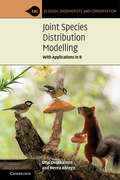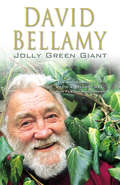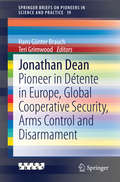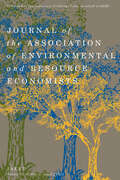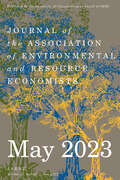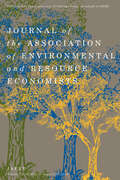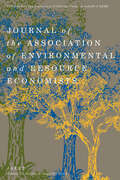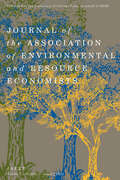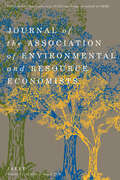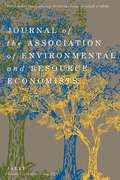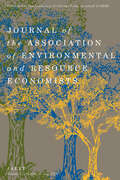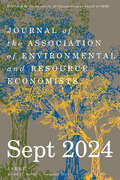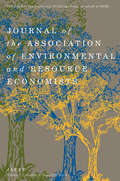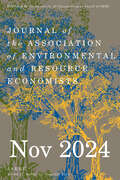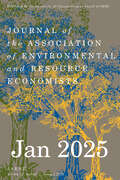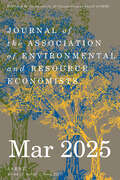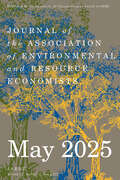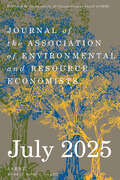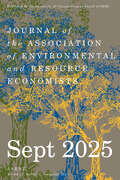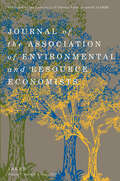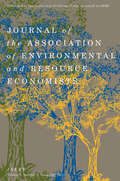- Table View
- List View
Joint Species Distribution Modelling: With Applications in R (Ecology, Biodiversity and Conservation)
by Otso Ovaskainen Nerea AbregoJoint species distribution modelling (JSDM) is a fast-developing field and promises to revolutionise how data on ecological communities are analysed and interpreted. Written for both readers with a limited statistical background, and those with statistical expertise, this book provides a comprehensive account of JSDM. It enables readers to integrate data on species abundances, environmental covariates, species traits, phylogenetic relationships, and the spatio-temporal context in which the data have been acquired. Step-by-step coverage of the full technical detail of statistical methods is provided, as well as advice on interpreting results of statistical analyses in the broader context of modern community ecology theory. With the advantage of numerous example R-scripts, this is an ideal guide to help graduate students and researchers learn how to conduct and interpret statistical analyses in practice with the R-package Hmsc, providing a fast starting point for applying joint species distribution modelling to their own data.
Jolly Green Giant
by David BellamyDavid Bellamy is a natural story teller whose memoir will be packed full of funny anecdotes and observations. It is the story of how a city boy, brought up in the middle of London, went for a trip into the countryside one day, an event which was to transform his life by setting in motion the amazing love of nature which would make famous this larger-than-life character. In his infectious style he illumines on, amongst other things, the fact that his father, the manager of a branch of Boots, had to grease his hair straight - because in those days managers of Boots weren't allowed to have curly hair! Then there was the time he and his brother discovered an exploded bomb, kept in the garden shed - and then accidentally blew off the front of the house with it. He reveals his secret passion is ballet dancing - and how his mother only found out about it when she saw him on stage at the Fairfield Hall in Croydon. His career as an academic, then author, broadcaster, consultant and television personality, spans 35 years and his main passion - campaigning for the environment - have led to many adventures including his being twice imprisoned in the Third World.
Jonathan Dean
by Hans Günter Brauch Teri GrimwoodJonathan Dean (1924-2014) was a distinguished U. S. diplomat (1950-1980) and from 1984 to 2007 global security adviser to the Union of Concerned Scientists, Washington, D. C. During the 1980s and 1990s he was a pioneering conceptual thinker, writer and speaker on détente in Europe, global cooperative security, arms control and disarmament. He authored: Watershed in Europe (1987), Meeting Gorbachev's Challenge (1989) and Ending Europe's Wars (1994). This volume contains his biography and bibliography, six texts on détente and arms control in Europe in the 1980s: Beyond First Use; MBFR; Alternative Defence; Berlin; A Crisis Management Center; Conventional Arms Control in Europe and six texts on the new security order in Europe since the 1990s: Components of a Post-Cold War Security System for Europe; Constraining Technological Weapons Innovation; NATO Enlargement: Act II; Ten Years after the Wall; Future Security in Space; Rethinking Security: Return to the Grotean Pattern.
Joshimath - Vikas ya Vinash?: जोशीमठ - विकास या विनाश?
by Shivendra Suryavanshi"जोशीमठ - विकास या विनाश?" शिवेन्द्र सूर्यवंशी द्वारा लिखित एक पुस्तक है जो उत्तराखंड के जोशीमठ क्षेत्र में हो रहे पर्यावरणीय और विकासात्मक परिवर्तनों पर केंद्रित है। पुस्तक का मुख्य उद्देश्य जोशीमठ के विकास और पर्यावरणीय प्रभावों के बीच के संबंधों की गहराई से जांच करना है। यहाँ इस पुस्तक का सारांश प्रस्तुत है: परिचय और पृष्ठभूमि, विकास की यात्रा, विकास के सकारात्मक पहलू, विनाश के चिन्ह, स्थानीय निवासियों की आवाज़, विकास और पर्यावरण के बीच संतुलन और निष्कर्ष और भविष्य की राह। शिवेन्द्र सूर्यवंशी ने इस पुस्तक में गहन शोध और स्थानीय अनुभवों के माध्यम से जोशीमठ के विकास और पर्यावरणीय चुनौतियों को प्रस्तुत किया है। यह पुस्तक उन सभी के लिए महत्वपूर्ण है जो विकास और पर्यावरण के बीच के जटिल संबंधों को समझना चाहते हैं और जोशीमठ जैसे संवेदनशील क्षेत्रों में टिकाऊ विकास की संभावनाओं का अन्वेषण करना चाहते हैं।
Jost Functions in Quantum Mechanics: A Unified Approach to Scattering, Bound, and Resonant State Problems
by Sergei A. RakityanskyBased on Jost function theory this book presents an approach useful for different types of quantum mechanical problems. These include the description of scattering, bound, and resonant states, in a unified way. The reader finds here all that is known about Jost functions as well as what is needed to fill the gap between the pure mathematical theory and numerical calculations. Some of the topics covered are: quantum resonances, Regge poles, multichannel scattering, Coulomb interaction, Riemann surfaces, multichannel analog of the effective range theory, one- and two-dimensional problems, many-body problems within the hyperspherical approach, just to mention few of them. These topics are relevant in the fields of quantum few-body theory, nuclear reactions, atomic collisions, and low-dimensional semiconductor nanostructures. In light of this, the book is meant for students, who study quantum mechanics, scattering theory, or nuclear reactions at the advanced level as well as for post-graduate students and researchers in the fields of nuclear and atomic physics. Many of the arguments that are traditional for textbooks on quantum mechanics and scattering theory, are covered here in a different way, using the Jost functions. This gives the reader a new insight into the subject, revealing new features of various mathematical objects and quantum phenomena.
Journal of the Association of Environmental and Resource Economists, volume 10 number 1 (January 2023)
by Journal of the Association of Environmental and Resource EconomistsThis is volume 10 issue 1 of Journal of the Association of Environmental and Resource Economists. As an official research journal of the Association of Environmental and Resource Economists, JAERE publishes papers that are devoted to environmental and natural resource issues. The journal's principal mission is to provide a forum for the scholarly exchange of ideas in the intersection of human behavior and the natural environment. Focusing on original, full-length research papers that offer substantial new insights for scholars of environmental and resource economics, JAERE presents a range of articles that are relevant for public policy, using approaches that are theoretical, empirical, or both.
Journal of the Association of Environmental and Resource Economists, volume 10 number 2 (March 2023)
by Journal of the Association of Environmental and Resource EconomistsThis is volume 10 issue 2 of Journal of the Association of Environmental and Resource Economists. As an official research journal of the Association of Environmental and Resource Economists, JAERE publishes papers that are devoted to environmental and natural resource issues. The journal's principal mission is to provide a forum for the scholarly exchange of ideas in the intersection of human behavior and the natural environment. Focusing on original, full-length research papers that offer substantial new insights for scholars of environmental and resource economics, JAERE presents a range of articles that are relevant for public policy, using approaches that are theoretical, empirical, or both.
Journal of the Association of Environmental and Resource Economists, volume 10 number 3 (May 2023)
by Journal of the Association of Environmental and Resource EconomistsThis is volume 10 issue 3 of Journal of the Association of Environmental and Resource Economists. As an official research journal of the Association of Environmental and Resource Economists, JAERE publishes papers that are devoted to environmental and natural resource issues. The journal's principal mission is to provide a forum for the scholarly exchange of ideas in the intersection of human behavior and the natural environment. Focusing on original, full-length research papers that offer substantial new insights for scholars of environmental and resource economics, JAERE presents a range of articles that are relevant for public policy, using approaches that are theoretical, empirical, or both.
Journal of the Association of Environmental and Resource Economists, volume 10 number 4 (July 2023)
by Journal of the Association of Environmental and Resource EconomistsThis is volume 10 issue 4 of Journal of the Association of Environmental and Resource Economists. As an official research journal of the Association of Environmental and Resource Economists, JAERE publishes papers that are devoted to environmental and natural resource issues. The journal's principal mission is to provide a forum for the scholarly exchange of ideas in the intersection of human behavior and the natural environment. Focusing on original, full-length research papers that offer substantial new insights for scholars of environmental and resource economics, JAERE presents a range of articles that are relevant for public policy, using approaches that are theoretical, empirical, or both.
Journal of the Association of Environmental and Resource Economists, volume 10 number 5 (September 2023)
by Journal of the Association of Environmental and Resource EconomistsThis is volume 10 issue 5 of Journal of the Association of Environmental and Resource Economists. As an official research journal of the Association of Environmental and Resource Economists, JAERE publishes papers that are devoted to environmental and natural resource issues. The journal's principal mission is to provide a forum for the scholarly exchange of ideas in the intersection of human behavior and the natural environment. Focusing on original, full-length research papers that offer substantial new insights for scholars of environmental and resource economics, JAERE presents a range of articles that are relevant for public policy, using approaches that are theoretical, empirical, or both.
Journal of the Association of Environmental and Resource Economists, volume 10 number 6 (November 2023)
by Journal of the Association of Environmental and Resource EconomistsThis is volume 10 issue 6 of Journal of the Association of Environmental and Resource Economists. As an official research journal of the Association of Environmental and Resource Economists, JAERE publishes papers that are devoted to environmental and natural resource issues. The journal's principal mission is to provide a forum for the scholarly exchange of ideas in the intersection of human behavior and the natural environment. Focusing on original, full-length research papers that offer substantial new insights for scholars of environmental and resource economics, JAERE presents a range of articles that are relevant for public policy, using approaches that are theoretical, empirical, or both.
Journal of the Association of Environmental and Resource Economists, volume 11 number 1 (January 2024)
by Journal of the Association of Environmental and Resource EconomistsThis is volume 11 issue 1 of Journal of the Association of Environmental and Resource Economists. As an official research journal of the Association of Environmental and Resource Economists, JAERE publishes papers that are devoted to environmental and natural resource issues. The journal's principal mission is to provide a forum for the scholarly exchange of ideas in the intersection of human behavior and the natural environment. Focusing on original, full-length research papers that offer substantial new insights for scholars of environmental and resource economics, JAERE presents a range of articles that are relevant for public policy, using approaches that are theoretical, empirical, or both.
Journal of the Association of Environmental and Resource Economists, volume 11 number 2 (March 2024)
by Journal of the Association of Environmental and Resource EconomistsThis is volume 11 issue 2 of Journal of the Association of Environmental and Resource Economists. As an official research journal of the Association of Environmental and Resource Economists, JAERE publishes papers that are devoted to environmental and natural resource issues. The journal's principal mission is to provide a forum for the scholarly exchange of ideas in the intersection of human behavior and the natural environment. Focusing on original, full-length research papers that offer substantial new insights for scholars of environmental and resource economics, JAERE presents a range of articles that are relevant for public policy, using approaches that are theoretical, empirical, or both.
Journal of the Association of Environmental and Resource Economists, volume 11 number 3 (May 2024)
by Journal of the Association of Environmental and Resource EconomistsThis is volume 11 issue 3 of Journal of the Association of Environmental and Resource Economists. As an official research journal of the Association of Environmental and Resource Economists, JAERE publishes papers that are devoted to environmental and natural resource issues. The journal's principal mission is to provide a forum for the scholarly exchange of ideas in the intersection of human behavior and the natural environment. Focusing on original, full-length research papers that offer substantial new insights for scholars of environmental and resource economics, JAERE presents a range of articles that are relevant for public policy, using approaches that are theoretical, empirical, or both.
Journal of the Association of Environmental and Resource Economists, volume 11 number 4 (July 2024)
by Journal of the Association of Environmental and Resource EconomistsThis is volume 11 issue 4 of Journal of the Association of Environmental and Resource Economists. As an official research journal of the Association of Environmental and Resource Economists, JAERE publishes papers that are devoted to environmental and natural resource issues. The journal's principal mission is to provide a forum for the scholarly exchange of ideas in the intersection of human behavior and the natural environment. Focusing on original, full-length research papers that offer substantial new insights for scholars of environmental and resource economics, JAERE presents a range of articles that are relevant for public policy, using approaches that are theoretical, empirical, or both.
Journal of the Association of Environmental and Resource Economists, volume 11 number 5 (September 2024)
by Journal of the Association of Environmental and Resource EconomistsThis is volume 11 issue 5 of Journal of the Association of Environmental and Resource Economists. As an official research journal of the Association of Environmental and Resource Economists, JAERE publishes papers that are devoted to environmental and natural resource issues. The journal's principal mission is to provide a forum for the scholarly exchange of ideas in the intersection of human behavior and the natural environment. Focusing on original, full-length research papers that offer substantial new insights for scholars of environmental and resource economics, JAERE presents a range of articles that are relevant for public policy, using approaches that are theoretical, empirical, or both.
Journal of the Association of Environmental and Resource Economists, volume 11 number 6 (November 2024)
by Journal of the Association of Environmental and Resource EconomistsThis is volume 11 issue 6 of Journal of the Association of Environmental and Resource Economists. As an official research journal of the Association of Environmental and Resource Economists, JAERE publishes papers that are devoted to environmental and natural resource issues. The journal's principal mission is to provide a forum for the scholarly exchange of ideas in the intersection of human behavior and the natural environment. Focusing on original, full-length research papers that offer substantial new insights for scholars of environmental and resource economics, JAERE presents a range of articles that are relevant for public policy, using approaches that are theoretical, empirical, or both.
Journal of the Association of Environmental and Resource Economists, volume 11 number S1 (November 2024)
by Journal of the Association of Environmental and Resource EconomistsThis is volume 11 issue S1 of Journal of the Association of Environmental and Resource Economists. As an official research journal of the Association of Environmental and Resource Economists, JAERE publishes papers that are devoted to environmental and natural resource issues. The journal's principal mission is to provide a forum for the scholarly exchange of ideas in the intersection of human behavior and the natural environment. Focusing on original, full-length research papers that offer substantial new insights for scholars of environmental and resource economics, JAERE presents a range of articles that are relevant for public policy, using approaches that are theoretical, empirical, or both.
Journal of the Association of Environmental and Resource Economists, volume 12 number 1 (January 2025)
by Journal of the Association of Environmental and Resource EconomistsThis is volume 12 issue 1 of Journal of the Association of Environmental and Resource Economists. As an official research journal of the Association of Environmental and Resource Economists, JAERE publishes papers that are devoted to environmental and natural resource issues. The journal's principal mission is to provide a forum for the scholarly exchange of ideas in the intersection of human behavior and the natural environment. Focusing on original, full-length research papers that offer substantial new insights for scholars of environmental and resource economics, JAERE presents a range of articles that are relevant for public policy, using approaches that are theoretical, empirical, or both.
Journal of the Association of Environmental and Resource Economists, volume 12 number 2 (March 2025)
by Journal of the Association of Environmental and Resource EconomistsThis is volume 12 issue 2 of Journal of the Association of Environmental and Resource Economists. As an official research journal of the Association of Environmental and Resource Economists, JAERE publishes papers that are devoted to environmental and natural resource issues. The journal's principal mission is to provide a forum for the scholarly exchange of ideas in the intersection of human behavior and the natural environment. Focusing on original, full-length research papers that offer substantial new insights for scholars of environmental and resource economics, JAERE presents a range of articles that are relevant for public policy, using approaches that are theoretical, empirical, or both.
Journal of the Association of Environmental and Resource Economists, volume 12 number 3 (May 2025)
by Journal of the Association of Environmental and Resource EconomistsThis is volume 12 issue 3 of Journal of the Association of Environmental and Resource Economists. As an official research journal of the Association of Environmental and Resource Economists, JAERE publishes papers that are devoted to environmental and natural resource issues. The journal's principal mission is to provide a forum for the scholarly exchange of ideas in the intersection of human behavior and the natural environment. Focusing on original, full-length research papers that offer substantial new insights for scholars of environmental and resource economics, JAERE presents a range of articles that are relevant for public policy, using approaches that are theoretical, empirical, or both.
Journal of the Association of Environmental and Resource Economists, volume 12 number 4 (July 2025)
by Journal of the Association of Environmental and Resource EconomistsThis is volume 12 issue 4 of Journal of the Association of Environmental and Resource Economists. As an official research journal of the Association of Environmental and Resource Economists, JAERE publishes papers that are devoted to environmental and natural resource issues. The journal's principal mission is to provide a forum for the scholarly exchange of ideas in the intersection of human behavior and the natural environment. Focusing on original, full-length research papers that offer substantial new insights for scholars of environmental and resource economics, JAERE presents a range of articles that are relevant for public policy, using approaches that are theoretical, empirical, or both.
Journal of the Association of Environmental and Resource Economists, volume 12 number 5 (September 2025)
by Journal of the Association of Environmental and Resource EconomistsThis is volume 12 issue 5 of Journal of the Association of Environmental and Resource Economists. As an official research journal of the Association of Environmental and Resource Economists, JAERE publishes papers that are devoted to environmental and natural resource issues. The journal's principal mission is to provide a forum for the scholarly exchange of ideas in the intersection of human behavior and the natural environment. Focusing on original, full-length research papers that offer substantial new insights for scholars of environmental and resource economics, JAERE presents a range of articles that are relevant for public policy, using approaches that are theoretical, empirical, or both.
Journal of the Association of Environmental and Resource Economists, volume 7 number 3 (May 2020)
by Journal of the Association of Environmental and Resource EconomistsThis is volume 7 issue 3 of Journal of the Association of Environmental and Resource Economists. As an official research journal of the Association of Environmental and Resource Economists, JAERE publishes papers that are devoted to environmental and natural resource issues. The journal's principal mission is to provide a forum for the scholarly exchange of ideas in the intersection of human behavior and the natural environment. Focusing on original, full-length research papers that offer substantial new insights for scholars of environmental and resource economics, JAERE presents a range of articles that are relevant for public policy, using approaches that are theoretical, empirical, or both.
Journal of the Association of Environmental and Resource Economists, volume 9 number 6 (November 2022)
by Journal of the Association of Environmental and Resource EconomistsThis is volume 9 issue 6 of Journal of the Association of Environmental and Resource Economists. As an official research journal of the Association of Environmental and Resource Economists, JAERE publishes papers that are devoted to environmental and natural resource issues. The journal's principal mission is to provide a forum for the scholarly exchange of ideas in the intersection of human behavior and the natural environment. Focusing on original, full-length research papers that offer substantial new insights for scholars of environmental and resource economics, JAERE presents a range of articles that are relevant for public policy, using approaches that are theoretical, empirical, or both.
